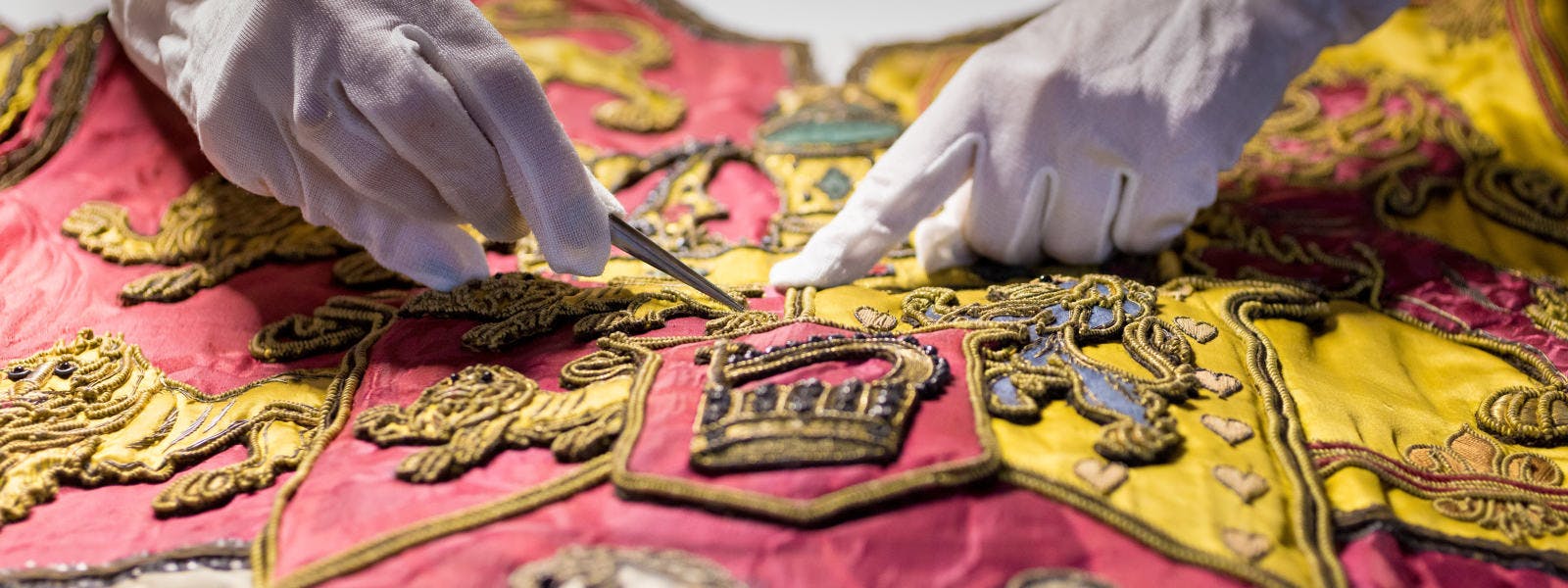
Preparing costumes for display
At Historic Royal Palaces, every object undergoes a thorough assessment to ensure it is in optimal condition before being prepared for display. Our treatment conservators carefully conserve any items in our collection that require special attention.
Displaying costumes is a unique art in textile conservation.
A costume should not only show the garment but also communicate its materials, construction, craftsmanship, historical importance, and the period and culture it represents. It can provide glimpses into the wearer's character or their role if known and to bring the dress to life.
Our textile conservators have a detailed understanding of costume construction and expertise in addressing diverse preservation challenges linked to historic costumes. Each costume is fitted on expertly crafted custom-made mannequins made of conservation-grade materials, with underpinnings to support the object. To achieve a seamless fit and drape without frequent handling, we often create a precise replica of the costume using cotton, known as a toile, for fittings.
Conservation mounting framework
Care is taken to ensure there is no strain or stress on fastenings. Cotton tapes may be added to the padded shape around the waist, arms, or shoulders to facilitate ease of fastening or positioning various supports inside the arms and legs, supporting underpinnings, and reinforcing their attachments to the body.
Skirts are supported with underpinnings to achieve the desired shape, support the weight of the fabric, and prevent creasing. Sleeves and trousers are also typically supported inside with soft arm or tubular-shaped supports to prevent collapsing and bring them to life.
Underpinnings need to be durable and securely sewn on the torso to maintain the relevant body shape and support for the duration of display. Various materials are used for underpinnings including synthetic polyester wadding, nylon net, non-woven polyester fabrics such as Fosshape™ and Reemay®, Rigilene® boning, and various pre-scoured pure cotton and silk fabrics.
In our costume displays, areas of a mannequin visible beyond the dress are often minimised or cut away to make the garment as the focal point for viewers. This 'invisible' mounting involves careful trimming of visible parts of the mannequin, extensive stitching, and covering the edges and inside of the torso in appropriate shades of silk custom-dyed to match the garment.
Final display
Though time-consuming, the careful process of conservation costume mounting guarantees to safeguard delicate displays in exhibitions while achieving an accurate appearance as worn and a desired posture for display. We are dedicated to continual learning and innovation, striving to create compelling costume displays.
Conservation in action

A gold 1920s wedding dress for the bride who wanted to shine
Hear from our experts
Conservator Anne-Marie Britton shares how her and fellow conservator Charlotte Gamper prepared this spectacular wedding dress for its display as part of Dress Codes exhibition.
Watch Conserving a Rare 360-Year-Old Dress Behind the Scenes
Watch our videos showcasing the process of displaying the fragile silver tissue dress and historic mantua dress, highlighting the care and intricate steps taken to prepare it for exhibition.
This content is hosted on YouTube
This content may be using cookies and other technologies for which we need your consent before loading. To view the content, you need to enable cookies for "Targeting Cookies & Other Technologies".
Manage CookiesExplore behind the scenes at the Textile Conservation Studio at Hampton Court Palace and discover how this remarkable dress from the reign of Charles II is carefully prepared for display.
Video transcript of conserving a rare 360-year old dress: Behind the Scenes.
Follow along with an interactive transcript of Conserving a Rare 360-Year Old Dress: Behind the Scenes at Hampton Court Palace on YouTube. A link to open the transcript can be found in the description.
